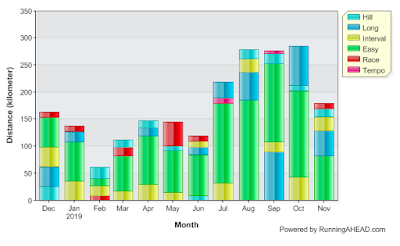I journey back to Southeast Asia, the one place where I have enjoyed sports glory in
recent years.
This year I enter two running races on consecutive Sunday mornings - the first -Bangkok’s Rama VIII Bridge 10k and the second event the Chiang Mai Mini-Marathon.
Between the events I travel the 700 kilometers between Bangkok and Chiang Mai by train and bus, spending several days in Thailand’s original capital- Sukhothai.
This year I enter two running races on consecutive Sunday mornings - the first -Bangkok’s Rama VIII Bridge 10k and the second event the Chiang Mai Mini-Marathon.
Between the events I travel the 700 kilometers between Bangkok and Chiang Mai by train and bus, spending several days in Thailand’s original capital- Sukhothai.
Sukhothai was the center of a vast empire
in the 13th century, but now it is a sleepy rural
town, way too far off the track to attract
hordes of tourists. This makes it an absolutely superb training destination.
The historic park area is a sprawling collection of
ancient temple ruins surrounded by well-groomed lawns – perfect for bounding and
strides.
The ancient city walls make for nice long contemplative runs on soft surface – especially in the hours around sunrise and sunset.
I just wish I was not so tired -- tired from my paranoid finishing kick over the final kilometer of the Rama Bridge 10k..
The ancient city walls make for nice long contemplative runs on soft surface – especially in the hours around sunrise and sunset.
I just wish I was not so tired -- tired from my paranoid finishing kick over the final kilometer of the Rama Bridge 10k..
The Rama Bridge
race, along an expressway in the hours before dawn, is flat, fast and relatively cool for this region. With so little to distract
me up on this expressway, I find myself locked in an internal struggle
to stay positive. I hit the turnaround in 18:44
and am told that I am currently 3rd
in my division. Knowing that only the top three receive awards, I obsess with fear of being overtaken. I am so paranoid, that despite my mounting fatigue I
somehow summon energy for a desperate surge with well
over a kilometer to go, accelerating my pace
to under 3:30 per k for over 800 meters. The final 500 meters is an
agonizing slog.
I manage 9th
overall and 2nd place in my division,
which means
big prize money— 4,000 baht (well, big money for me anyway given my impoverished financial situation and low costs in Thailand). With my race times slowing down and always one other guy seeming to show up and blow me away every race, I look for triumph wherever I can.
My official chip time for the 10-kilometer? distance is a respectable 37:16. But upon seeing the results afterwards I wonder if maybe I should have been more tactical -- and saved energy for running in Sukhothai and for Chiang Mai.
big prize money— 4,000 baht (well, big money for me anyway given my impoverished financial situation and low costs in Thailand). With my race times slowing down and always one other guy seeming to show up and blow me away every race, I look for triumph wherever I can.
My official chip time for the 10-kilometer? distance is a respectable 37:16. But upon seeing the results afterwards I wonder if maybe I should have been more tactical -- and saved energy for running in Sukhothai and for Chiang Mai.
So then during the
weeklong journey north I sleep 10 hours per night to fight off a cold and to
ready myself to defend my age group title at Chiang Mai.
This is my 4th
time running the Chiang Mai 10k, but this year the kilometer marks are short which
makes me believe that I am running much faster than I am – this helps give me a confidence boost
early and makes the race more enjoyable than the stressful, mental challenge of
the previous week. I am only slightly disappointed as I note the rather slow
time of 40:45 for 10.5-kilometers? when I cross the finish line. Most any
disappointment is dispelled when finish line volunteers put the division 1st
place tag around my neck.
At Chiang Mai I win
3,000 baht of prize money
 At the awards ceremony we discover that we are not the only athletes traveling and working
the Thai running circuit. We meet Kindu Swemehon who had also competed in
both the Rama Bridge and Chiang Mai races. However Kindu competes in the
half-marathon and full marathon and is the overall winner of both of
them. So as rugged as we might claim that our week of travel and racing was,
it is relaxing compared with Kindu. For now I will hold off on leaving my day job and joining the
Southeast Asia Running Tour full-time.
At the awards ceremony we discover that we are not the only athletes traveling and working
the Thai running circuit. We meet Kindu Swemehon who had also competed in
both the Rama Bridge and Chiang Mai races. However Kindu competes in the
half-marathon and full marathon and is the overall winner of both of
them. So as rugged as we might claim that our week of travel and racing was,
it is relaxing compared with Kindu. For now I will hold off on leaving my day job and joining the
Southeast Asia Running Tour full-time. 

































